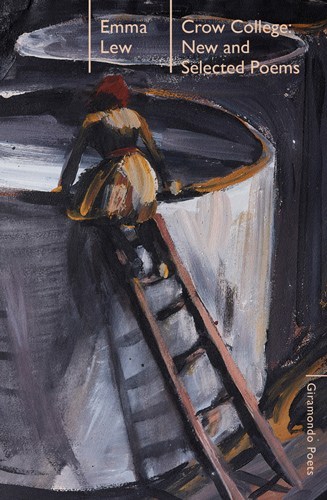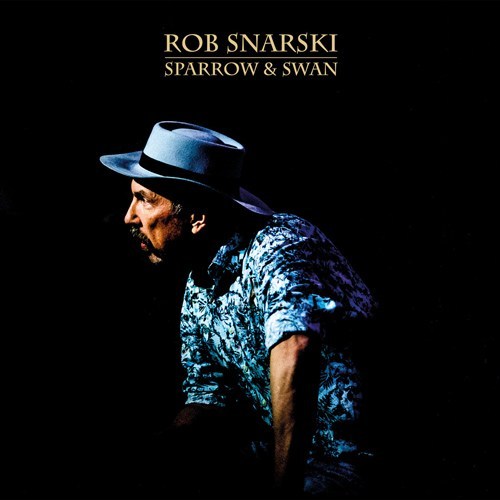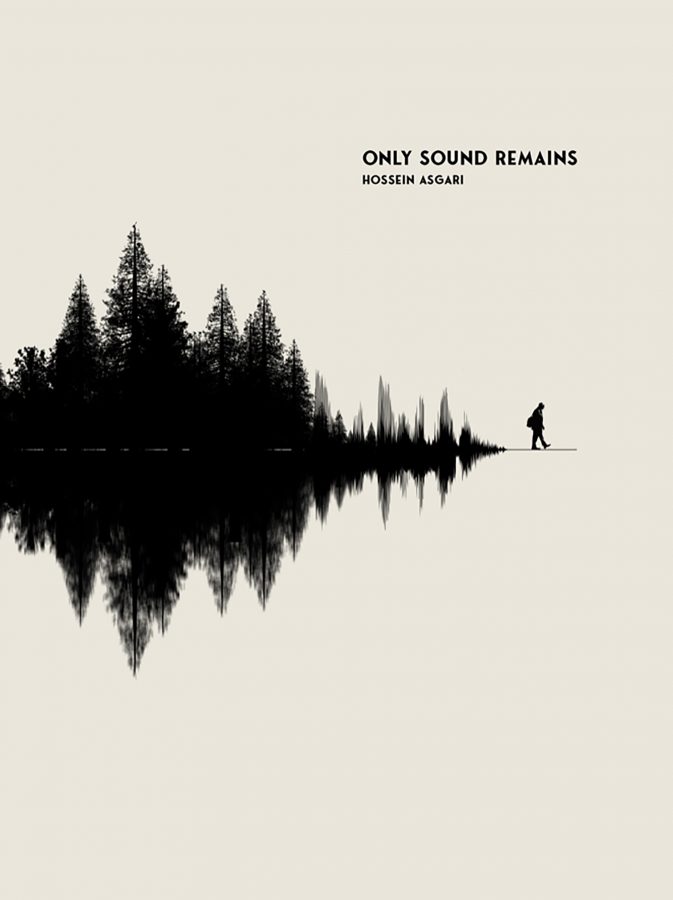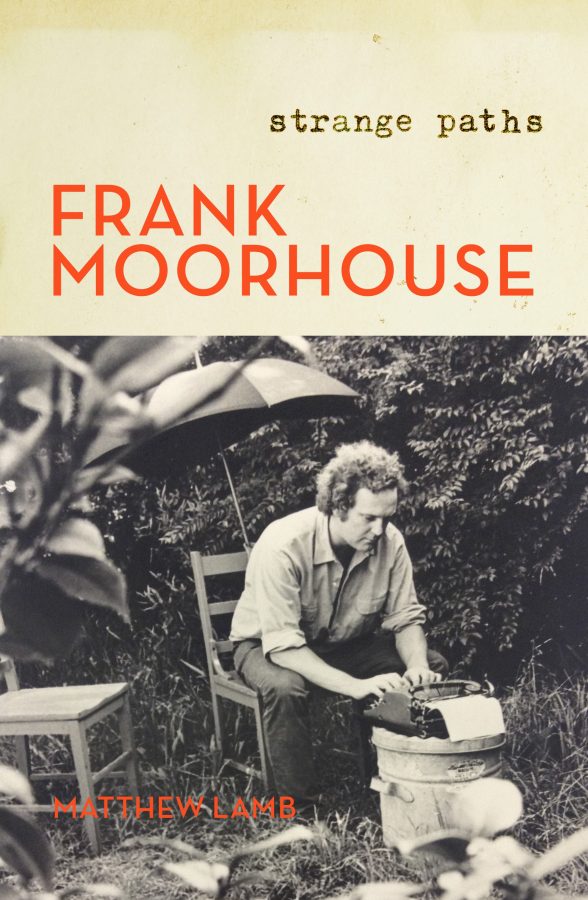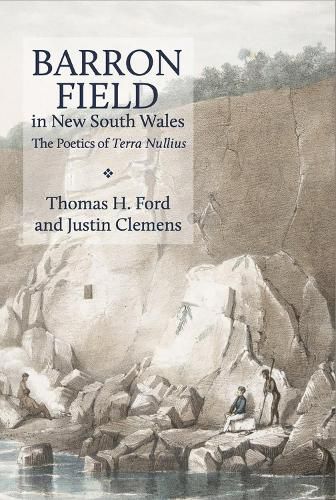It has always lived in Emma Lew’s poetry, a welling darkness that steeps the reader while notions and emotions wick along the word-strings to deliver a gloom that is oddly illuminating. Consider, for example, this clip from ‘Thebes’ in Lew’s first-published collection, The Wild Reply (1997):
Stormlight and the
coming-on of night.
Moan of planets, mice
on the path. The dark
charge of doors and
the lake that burns.
‘Stormlight and the coming-on of night … … … the lake that burns’. Fans of the Netflix series Stranger Things might envisage the upsidedown, the implacable, id-rushing realm that throbs inside the waking world. Or you could recall Patrick White’s epigraphic translation of Paul Eluard at the start of The Solid Mandala: ‘There is another world, but it is in this one’.
In the title poem of The Wild Reply Lew notes how ‘mirage seeps in’. And in ‘The Recidivist’, from the same collection, she ponders ‘the haunted moment when night refills with fresh blood’. So this is a given: in Lew-world the otherworld always presses. There is a valence in Lew’s language, an instilled quality of extra-potentiality, of sinister burgeon. Verses contain verbal capsules from which scalding stories want to surge, as if pushed forth by remnant ache. Here’s an example from ‘Sinking Song’: ‘You, me, money and fear’. On first encounter, such an image-nub seems projectile; you assay the density and then thoughts and feelings fire off from your memory and imagination. Lew’s compactions seem to flare with a poetic force rushing to the horizon, as in another snippet from ‘Sinking Song’, worthy of a Seijun Suzuki movie: ‘fire runs along us as a man’.
Typically, Lew delivers some concussion that aches in memory or that glisters as a desired future moment, ready to alter the light in which existence is presently apprehended. Ruction usually lurks in her language, primed to discommode the fierce urgency of now with a wonky new setting for the lens that trains the light of cognition on each present moment poised between reflection and prospection. Poems like ‘Sinking Song’ have the anticipatory tang of burning fuse-cord.
But does the detonation inside the poems really trigger an outburst of thoughts and feelings? With the recent release of Crow College – Giramondo’s potent compendium of old and new pieces – Lew enthusiasts now have a clearer forensic view of the derangement. Appraising Lew’s writing across the long-durée of three decades, we notice that most of the poems are actually implosive or inward-driving rather than explosive. In poem after poem, the reader notices the verses building a weird, centripetal pressure. As you read, your cogitation feels evermore sucked-in rather than flung-out.
In fact, in the opening lines of ‘Sinking Song’, planted in plain sight, you’ll find a clue about attraction: ‘We are just strong enough/ to make the tides work for us’. Here the moon lures along; absorptive, its force does not push or blast outward. Soon come the following lines: ‘cities, built merely to fall,/ drown in birds’. Lew-world is prone to crumble, fall and smother into itself. Loss-laden, introjective, this world is devoid of energetic outbursting; instead, there’s plenty of immolative, osmotic collapse.
After you read and re-read awhile, you adjust your first impression about the volatility of Lew-world. You comprehend that she builds most of her poems around verbal devices that serve as vacuum pumps rather than gelignite lumps. There are no fireworks. Instead, a lot of things suck.
To explain how the ‘suction’ works, it’s good to tell it slant. In Jay Leyda’s visionary almanac The Years and Hours of Emily Dickinson, he offers this casual epiphany:
A major device in Emily Dickinson’s writing, both in her poems and in her letters, was what might be called the ‘omitted center’. The riddle, the circumstance too well known to be repeated to the initiate, the deliberate skirting of the obvious – this was the means she used to increase the privacy of her communication … To force her reader to ‘hear between the lines’ was a method that, if unrecognised, made her messages puzzling to some contemporaries. All her puzzles had keys, and it was not her fault if the reader was too impatient to seek them. Many of her best poems (perhaps especially the best ones) screen their kernel from a superficial reading. She must have enjoyed arranging for the moment of revelation, when all falls into place. Once found, the center impresses itself on the mind and memory more than if bluntly stated.
Lew’s writing is similarly void-drawn. In ‘My Illusion of the Tycoon’, she declaims, ‘What haunts is the absence the eye collects’. Which prompts us to re-examine the list from ‘Sinking Song’: ‘You, me, money and fear’. We can see now that those five words do not constitute a cluster-bomb; rather they are a ring of dark water around an absorbing omission. Whatever is at stake, it’s best not to say. Readers will feel they are in on the conspiracy even as they are not granted any divulgence. Paranoia ignites and fast-flowing speculations whoosh into the absence. Or letting go of the water metaphor, perhaps readers sniff what John Berryman described as an implosive ‘fire burning without outlet, consuming acrid its own smoke’. Either way, wet or dry, cool or hot, silence brings puissance. If any significance comes into focus in a Lew poem, it tends to ‘fall into place’, sliding inward to the attractive dark of the reader’s private, contemplative core, drawn through cached memories, through fears, hankers and wishes.
In ‘Marshes’, Lew sets a scene : ‘I wait for storms/ to crack the glamour open’. By now we know that through such cracks, disturbance must seep inward. In Lew-world, seepage and slippage almost always glug into firm common sense. Surface glamour offers no lasting, out-reflecting protection. In other words, every scene is unstable, impelled by mutability, ready to thicken somewhat dreadfully.
A close reader might note the language of instability that I‘ve used in the last paragraph or two: ‘fall’, ‘slippage’, ‘flow’, ‘seepage’, ‘glug’, ‘whoosh’, ‘sliding’. These kinds of words – signifying motility, restlessness, entropy – these kinds of words are needed in accounts of Lew-world, for this world is a mangle of scenes where characters, intrigues, habitats and brittle stutters of time-tempo are all on the move, always falling into some other state. As Lew observes in ‘Speculative Realms’ (one of the new poems): ‘The future evolves in the absence of meaning […] Chaos persists and leads to inner haunting, spreading ruinously, as in dreams’. (Ellipsis mine.)
Lew composes a world where every component might exert a sinister attraction on every other, where elements are primed to transmogrify and shift into some new meld, as in dreams, while the elements are drawn toward each other. I’ve already mentioned Jay Leyda and his brilliant work on Emily Dickinson. Another of Leyda’s specialities is early Soviet cinema, especially the editing principles of Sergei Eisenstein. A key notion for Eisenstein is the ‘montage of attractions’, an almost-mystical conviction that particular snippets of the world are attracted to each other, lured and conjoined by the force of truth, and that in such conjunctions sparks of revelation can fly out to brighten the gloom that false consciousness always palls around external reality. For Eisenstein, the world wants to be illuminated; we just need to gather the mutually attractive elements so that our daily conditions can shine against the obfuscations of false consciousness; and cinematic montage brings such clarity when apposite or accurately attractive clips are struck together – flint knocked against flint – on the editing bench. In the most revelatory cinematic sequences, things that seem not to be congenial get joined in such a way that latent truths are suddenly perceptible. In other words, via the montage of attractions, the world can be lit up when seemingly non sequitur elements are shown to be sequitur or righteously sequenced.
Sometimes this conjunctive cogency occurs in dreams, sometimes in films, sometimes in poems. Most of Lew’s lists seem to have been compiled in the upsidedown. Auditing her sequences, the reader senses an occult ‘logic’. Brightening sparks do not fly out to reveal external truth; instead the reader becomes thicker and more resonant inside with ‘the coming-on of night’. It is like the exquisite doom that zen scholars call ‘yugen’, a kind of unstinting aesthetic resonance founded on shadowy darkness. Whereas Eisenstein wants a scientific-socialist world, something objectively out there, explicatory, that can be rendered interpretable by editorial flintlight, Lew concentrates instead on an ambiguous inner world limned by dark charges and stormlight. (I have already invoked the Eluard epigraph from The Solid Mandala. It might be time now to quote the one that Patrick White borrows from Meister Eckhart: ‘It is not outside, it is inside: wholly within’.) Other to the objective precepts that Eisenstein sought to reveal, Lew conjures a subjective, phenomenological poiesis where meaning and aesthetic force reside not in the outside world but within the perceiving subject. The power in her poems runs along a psychic seam where the reading-self ingests listed details of observed experience such that meaning puckers downward, inside the perceiver, to congeal around the idiosyncratic memories and desires carried deep and concealed by every one of us.
Therefore many of Lew’s poems stir a ‘dead language in/ the blood. A fury locked/ in the body crepuscular’ (‘Thebes’). Appearing sometimes like transcripts from wire-tap surveillance in a franchise-barn cafeteria, sometimes like Soviet-era espionage-codes, her phrasing – runic as it can sound at first – almost always sweetens to cogency. For example, feel the compelling shape of that well-wrought line from ‘Thebes’: ‘a fury locked in the body crepuscular’. Via melody, banality can freight truths to the intellect through the reader’s pattern-seeking aesthetic faculties. Which is to say, Lew trusts that language can encapsulate lived experience as a system of perceptions that is survivable and cerebrally navigable, even if life is not always delectable. Something in the morphology of the verses renders her non sequiturs sequitur. For, not too long after the aesthetic faculties have been galvanised, the intellect does get the message.
Examples?
The opening stanza of ‘Afterlife’:
The whisper of a heavy car.
The darkness of trees and behind the darkness.
The pipe, the cool hills and the man.
Things you only buy once in a lifetime.
Or this from ‘Luminous Atlas’:
There’s a lot of mystery in the world,
stuff I never read in languages I don’t speak.
Saddest circus I ever saw.
I do crave love, but is this the place ?
I’m sorry if I added darkness,
but I couldn’t just show up empty-handed.
Time to cut and run. It’s a sensitive subject.
Even the rain is black. Is everybody helpless here?
Or consider the odd integrity of the full dozen lines of ‘Flourish’:
I never bet on melancholy
There’s parish in the spittle of an angry man
Fame is the shell which preserves that thunder
The late bloomer has become the talk of the town
Truth is a jewel to avoid
I’ll show you a relic equally holy
A beautiful plan, where everyone ends up happy and rich
What I want is to get this pain off my body
Irony is the rage that fails
Look at me: I’m blind, I’m living a wonderful life
I rise early and take the hazardous road
The curse has fallen on me too, but in reverse
Each element in a Lew-list rides a cusp between personal mnemonics and communal symbolism. Even as the reader can hear themself saying and owning a line as if it is a personal secret, there’s also a sense that a small society of other people might be similarly inculcated, a sense that the mesh-wire of connected feelings strung through the sequence does in fact tell a worldly truth that connects the isolato reader to a communal consciousness nearby. The point is, because each listed item triggers a memory or a desire that lurks latent within the resonating reader, the articulated sense of the entire list – the meaning of the poem in the long run – is first found inside every reader before it appears, communicable, across the objective world outside. There is a flooding-in before there is a bursting-out. Once again we note that Lew detonates implosions which draw meaning together within the ruminator before any message gets projected or exploded out to any public forum. Personal insights have to light up before acknowledgement can bring a shared, broadcast overview. Cryptic privacy precedes the codifications of meaningful publicity. Whenever a Lew-list moves from being non sequitur to sequitur, the shift away from inscrutability has occurred because each item on the list first finds a way to gleam over to every other item inside the internal gloom of the reader’s idiosyncratic, desire-soaked memoryscape. The codes that cohere when the non sequitur moves to the sequitur are as loose and fluid (and weirdly systematic) as the unconscious.
When riffing along the cusp-line between private cryptics and public semantics the poet must stay just inside the range of transmission to one’s fellow-citizens. Snarky reviews of Lew’s poetry complain that it is preponderantly psychedelics. For the unpersuaded, Lew dithers too much in outlandish symbology. And it’s true that in order to deliver revelatory sequencing, a poet needs to be Martian enough to have rare ‘othersight’ but not so alien as to be incommunicado or inscrutably mystic. To chasten the Martians, think of a few of the offerings from later-period Scott Walker. (Bish-Bosch for example, from 2012, which the world has not yet caught up to.) But contrariwise, to vouch for aliens, think also of how Walker’s now-pellucid Climate of Hunter seemed impenetrable when it was first issued in 1984. Think too of Francis Webb, how utterly apposite his verbal pile-ups can sound today. Ditto Miles Davis’s 1971 Jack Johnson album, which used to be ugly clatter but which presently sounds so attuned to everyday life that you sometimes hear it sparring with the stereo speakers in modish cafes.
By my lights, Lew is like Walker, Webb and Davis – just the right amount of Martian – in the way she can make the noise fall away to ensure a distinctive signal comes through the strangeness. Exhibit A is all the quotes I’ve already offered. Exhibit B might be this sparkling-dark run from ‘Ghetto Poem’:
Anyone may stumble all of a sudden.
Trust is a laudable virtue only in ordinary times.
With awe and reverence, I am hiding
the pages that can tell about the quiet groans.
I have trifled with the fear of death,
the shameful recoiling and desire to strike.
But can one wear the clothes of someone who has perished?
In overview, there’s more to admire than just the visionary sequencing. In overview, what is remarkable, indeed thrilling and protean, about Lew at her best is the way she layers extra richness over the free-jazz oneirics. Paradoxically (and therefore, I think, characteristically) she also yokes herself to tightly-structured regimes. For example, with the new poems in Crow College she regularly obeys the strictures of the pantoum, a poesy-pattern that she began exploring two decades ago. Dictionary.com gives a prosaic definition: ‘PANTOUM – a Malay verse form consisting of an indefinite number of quatrains with the second and fourth lines of each quatrain repeated as the first and third lines of the following one.’ And Bella Li, in her lucid ‘Introduction’ to the Giramondo collection, helps us sense the poetry when she observes that pantoums perform a ‘kind of sonic haunting, through echo and return’.
Here’s how the pantoum-pattern plays in the first three stanzas of ‘Avalanches’:
I travelled like a curse
hunting when the ice was moving
my hands, for once, staying still, not stealing
but I saw what I was doing, and seeing it broke down my silence
hunting when the ice was moving
not just any stranger pushing her own decay
but I saw what I was doing, and seeing it broke down my silence
I saw it all, the wolves howling
not just any stranger pushing her own decay
still trembling like the sun
I saw it all, the wolves howling
dividing the remnant again and again
Actually, it’s perfect to call the poem ‘Avalanches’, for the reader observes swathes of tenuous structure slipping and relocating while sense unmoors and re-moors, displacing and overriding while portions of the stanzas crumble like snowdrifts declining to settle. Some force breaks through the line and pushes it under and elsewhere so that it can re-emerge by breaking into other lines a few breaths away. The trope stutters your expiration and inspiration. Or here’s another way to think about it: the pantoum stanzas play out in your sensibility in much the same way that your frail memory phase-shifts and twitches to refocus inside your troubled, history-blathered sensibility. Something you think you know disappears or falls out of good order, only to reappear in a new sequence, promiscuously rousing fresh meanings or imaginings by dint of each recycling new alignment. Avalanche-like, cognition crumbles and slides even as memory tries to hold the ground. But crystal-like, cognition also recalibrates and branches out as the slipped verses return next time with a gloss of familiarity, primed thus to super-charge the new words wrapped around them.
Think of the celebrated ‘spring-thaw’ chapter of Henry David Thoreau’s Walden:
Few phenomena gave me more delight than to observe the forms which thawing sand and clay assume in flowing down the sides of a deep cut on the railroad through which I passed on my way to the village … The material was sand of every degree of fineness and of various rich colors, commonly mixed with a little clay. When the frost comes out in the spring, and even in a thawing day in the winter, the sand begins to flow down the slopes like lava, sometimes bursting out through the snow and overflowing it where no sand was to be seen before. Innumerable little streams overlap and interlace one with another, exhibiting a sort of hybrid product, which obeys half way the law of currents, and half way that of vegetation.
Observing nature stagger and regroup and continue to grow in this paragraph, you see how Thoreau’s drama of transmogrification, organic in the way it organises, perfectly shadows the crumble of memory that is mimicked in a pantoum, where amnesiac slippage undercuts certainty and makes new configurations of cognition when the motile reminiscences re-stack one upon another. In other words, within the finicky sequences of pantoum-patterning, the writer and the reader come to know afresh the heuristics of apposite conjunctions that parlay the non sequitur into the sequitur.
Lew has deft control over the slippages and feelings of wonky realignment provisionally installed, so much so that she sometimes adds a detail extra to the pantoum-avalanching that plays out stanza-to-stanza. Inside single lines, occasionally, she lets loose additional instability. For example, take this seemingly simple line from ‘Seven Days to Apologise’: ‘Just don’t say the mood is doomed’. See and hear the way ‘mood’ dissolves and rearranges its letters before sluicing over to become ‘doomed’. Or revisit the three stanzas from ‘Avalanches’, quoted above, to see and hear how the sound plays jittery in the line, ‘ my hands, for once, staying still, not stealing’. The motility is remarkable, the way the word ‘still’ actually makes the line twitch and stay not still, as the sibilance and sonic rhythm and visual punctuation all crank a spring super-tight around the trigger-phrase ‘not stealing’, a phrase that you envisage snapping back like a mouse-trap over the rest of the tensely set line. And even more bravura is the way that Lew reprises the word ‘still’, two stanzas later in the oxymoronic line ‘still trembling like the sun’, to prove that stillness in Lew-world does not hold. Existence decays and trembles and will doubtless soon shift.
This dexterity with lines that buckle as they run, it lingered in my mind when I finished my first stint with Crow College and then made what I thought was a non sequitur move to take a deep dive into the new album, Sparrow and Swan, by Melbourne-based singer-songwriter Rob Snarski. Well, it so happens this move is NOT non sequitur. And it’s not just the bird references in the titles. For, Lew-like, Snarski’s songs have both a sequence-driven, list-crystallising poetic and a pantoum-quality that he generates by deploying aesthetic and semantic patterning to dramatise displacement and return.
Examining the pantoum-quality first: many of the songs on Sparrow and Swan carry the haunting and the sense of echo and return that Bella Li identifies in Lew’s poetry. The main echo comes from Van Morrison, explicitly so in the song at the centre of the album, a nine-minute wonderment called ‘Chasing Van’, in which two teenaged girls from the Catholic side of Trouble-riven Belfast tear the night apart, seeking the mirage of the great Protestant soul singer. (After the girls survive all the risks, Snarski sings, ‘Who was it saved you girls tonight? Was it an apparition? Was it THE apparition?’)
To chase the spirit of Morrison is to chase a troubled spectre, or more accurately a doubled spectre: a figure of great anguish who is also a saviour capable of dispensing transcendent, almost-unutterable beauty. For in addition to dwelling for long periods somewhere close to musical heaven, Morrison has spent his life adrift in disphasure, echo and ghosting, this England-aligned Irish bluesman kinked out of register with the larger portion of his Papist homeland, weightless most of his life displaced in American mega-stardom, seeking constantly to blend evangelical impulses with African-American soul-sensibilities saturated by Celtic balladry. He is a cipher that Snarski conjures so as to sing of estrangement and belonging, the twinned thematic pang that courses through Sparrow and Swan.
In ‘Chasing Van’ the pantoum-quality plays out musically more than textually. Lines of language do not literally slip around, stanza to stanza in the way Lew’s pantoums crumble, slide and reassemble. With Snarski, the slippage occurs in the vocal phrasings and the melodic cadences rather than with the text itself. The effect and affect are set up with a one-two manoeuvre, like this: first, ‘Chasing Van’ repeatedly and explicitly presents the idea and the musical stylings of Morrison in the jazzy-runs of Shane O’Mara ‘s guitar-work, in the luscious flow of Snarski’s balladry and in the canny mimicking of Morrison’s famous incantatory lyric-writing; second, once these explicit notations are installed, the deliberate mimicry drops away and Snarski’s own confident and distinctive style takes over in such a way that the spookily present absence of Morrison haunts the singing and songwriting for a while, drawing Snarski’s warm, fluid vocals into the omitted centre of the song’s stylistics. And the one-two manoeuvre repeats again and again throughout the song: explicit references to Morrison and his lyrics return while Van-style incantations thread verse to verse, until Snarski’s own words and vocal tone take charge again, with the pantoum-effect causing Morrison’s presence to slide around, submerging and re-emerging continuously – a presence there but not there – appearing, withdrawing, echoing, returning, haunting.
Perhaps the most thrilling moment is when Snarski chants a sinuous sequence describing a talisman that the girls carry throughout their quest:
Our Lady of Graces dangling on a chain, little golden noose, telling all your faith, the medal miraculous, the medal miraculous, miraculous, miraculous, telling all your faith.
This passage delivers a lulling musicality that shadows not only the way Morrison often chants his lyrics (as in ‘Listen to the Lion’ on the overlooked masterpiece Saint Dominic’s Preview) – but also the way Lew often lets fall an inebriating incantation, such as ‘a fury locked/ in the body crepuscular’ (from the poem ‘Thebes’) which momentarily establishes rhythmic reliability and aesthetic fulfilment before the next breath of slippage erodes the remainder of the stanza. Thus with his writing and his vocal phrasing, Snarski has developed a quite exquisite ability to call and host ghosts. ‘Chasing Van’ for example, is stippled with seemingly non sequitur references to the absence of the Celtic superstar: ‘no red sports car … no TB sheets, no Spanish Rose, not a Spanish Rose”; but simultaneously, Snarski regularly presents Morrison within the seeming absence, by channelling signature phrases in commentary-choruses: ‘here comes the night … now the healing has begun … I wanna comfort you … Lyndon Arden stole the highlights … I wanna … I wanna comfort you’. (For non-initiates: trust me – these are all canonical Morrison phrasings.) In song after song on Sparrow and Swan, Snarski produces such ‘ghost-singing’ and ‘ghost-writing’. With his soul-soaked Australian voice, he goes chasing the hybrid Celtic-blues stylings of the transatlantic Irish troubadour.
Famously a Morrison song is almost always driven first by the cogency of its cadencing rather than by the rules of grammar or by tidy, connective logic. Take, for example, the oft-lampooned yet avidly loved sequence in ‘Beside You’, from Astral Weeks, where Morrison sing-drawls, ‘Way across the country where the hillsides mount and glide, the dynamo of your smile caressed the barefoot virgin child to wander past your window with a lantern lit’. Granted, it reads ridiculous on the page, but aesthetically-impelled emotional flow is what matters here; and when you hear the passage sung, a sensible message does catch up to the surging feelings. The sustained aesthetic wallop of the phrasing bunts the song to an ecstatic plain.
Happily haunted by Morrison, Snarski is well able to match the master. One example:
The road’s a broken string, highway black ribbon, rolling, rolling, rolling and rolling, rolling on. Feathers glisten in the sun of a lone black swan that glides along the shallows, past the lilies and the reeds, bluebirds and weeds, towards the willow (‘Sparrow and Swan’).
Another example:
Now I’m running off a half-back flank, breaking through the lines, sailing over fields of green, breaking through the lines, no fear or pain, no fear, no fear of pain, no fear (‘Number 44’).
In the incantation (‘no fear or pain, no fear’ … ‘breaking through the lines’) you can hear how, Morrison-like but also Lew-like, Snarski works a process whereby a chant starts out non sequitur and then slides over, via its aesthetic patterning more than via its semantic disquisition, to become cogent and comforting somehow, as the phrasing and melodics of the language as well as the metaphorics of the conjunctions all knit to reveal a ‘sequitur’ cohesion in the listing. For me, Brisbane-haunted as I am, the finest ‘non sequitur sequitur’ instance in Sparrow and Swan comes at the end of ‘Conversation with a Brisbane Cab Driver’, where Snarski strings together a travelogue of suburbs that are rhythmically and melodically perfect at the same time as they map a configuration of emotions that encompasses exactly the mood of the scalded town:
frangipani, jacaranda, Spring Hill, flame tree, Zillmere, Ashgrove, New Farm, Fig Tree Pocket, ponciana, Woolloongabba, Tennyson, Nebo Mountain, Bracken Ridge, Sunnybank, Tarragindi, Fortitude Valley, Eight Mile Plains, Brisbane Airport.
My summary point is this: with the list-chanted search for aesthetic cogencies and with the melodic and phraseological ghosting of Van Morrison’s great legacy, we hear in Snarski’s songs a haunting that harmonises with Lew’s affinity for stormlight and the coming-on of night. And this double-visioned attentiveness to othertimes and elsewheres that Lew and Snarski share, this attunement to amnesiac slippage and echoic revisitations, it all manifests as a national style. I borrow this notion from Robert Alter’s mighty book, Pen of Iron: American Prose and the King James Bible. Alter contends that once a writer has developed a mature style, it ‘is never a technical or “aesthetic” procedure but a way of imaging the world, of articulating value’. For Alter, style is ‘the vehicle of a particular vision of reality’. And by extrapolation, sometimes a phalanx of writers from one particular polity concur stylistically in such a way that readers find themselves communing with a national style. By Alter’s reckoning, this has occurred in America, under the orotund, rhetorical influence of the King James Bible, such that an American timbre can be heard again and again through a lineage of authors running from Hawthorne, Melville and Lincoln through Hemingway and Bellow to Marilynne Robinson and Cormac McCarthy.
Of course, when we pull focus to the Australian scene, a couple of writers do not constitute a style or a school. And I don’t wish to burden Lew and Snarski with a Universal Theory. But I do think there is something nationally characteristic and illuminating in the traits these two peculiarly Australian artists share. Unsettled, supple, prone-to-slippage, pattern-seeking, amnesiac but also memory-craving, the style shared by Lew and Snarski is one deployed by people who have come to understand that they are not naturally at home, people who look and listen for memories (personal and familial) that transmit over geographical and generational horizons, back to wartime Europe, back to parents and forebears speaking other languages, back to ancestral memories that are not lit by local light. Lew and Snarski are people who do the looking and listening via aesthetic means – verbal, musical, formal, traditional, innovative, ghostly. They seem mordantly local. They seem parochial in the best sense, which is to say they are bearing close witness in this our mean, haunted parish of the south. And I think the memory-deepened works they’ve published this year are some of the most wide-awake and dream-driven things to have been uttered here in a good while.
Works cited
Robert Alter, Pen of Iron: American Prose and the King James Bible, New York: Princeton University Press, 2010.
John Berryman, his Selected Poems 1938 – 1968, London: Faber & Faber, 1972.
Jay Leyda, The Years and Hours of Emily Dickinson, New Haven: Yale University Press, 1960.
Henry David Thoreau, Walden, fully annotated edition, edited by Jeffrey S Cramer, New Haven: Yale University Press, 2004.
Patrick White, The Solid Mandala, New York: Viking, 1966.
